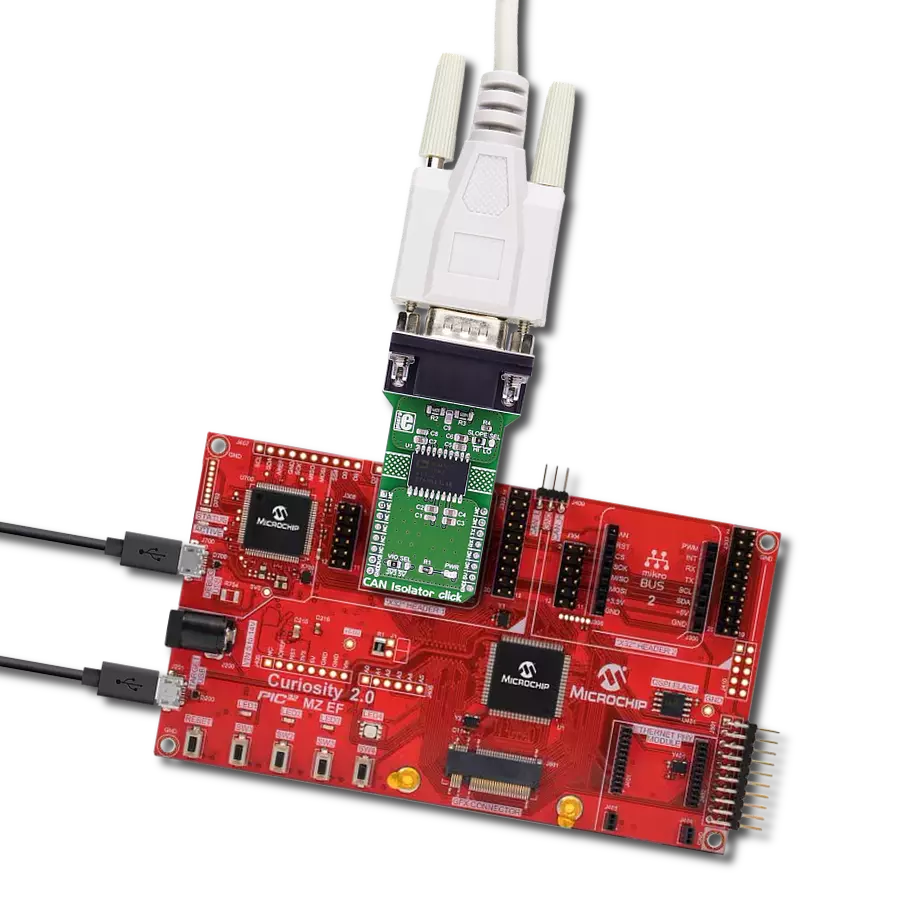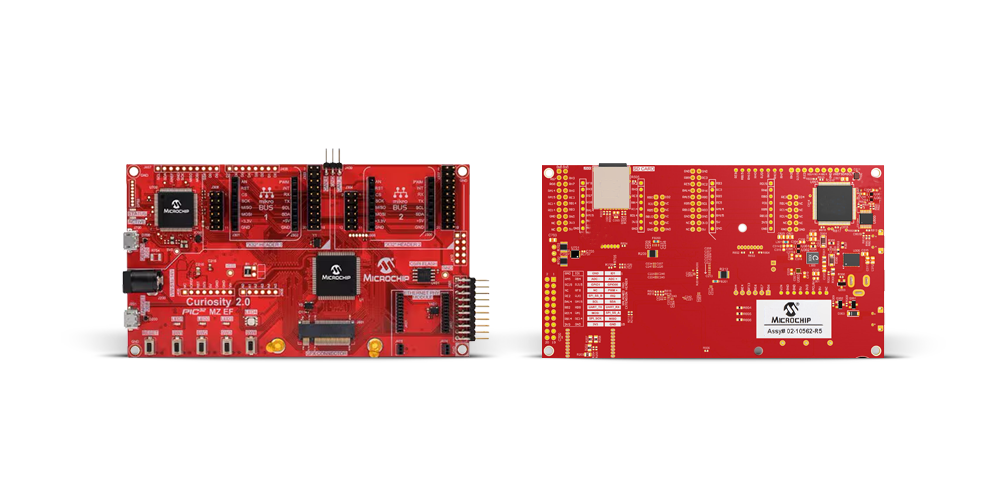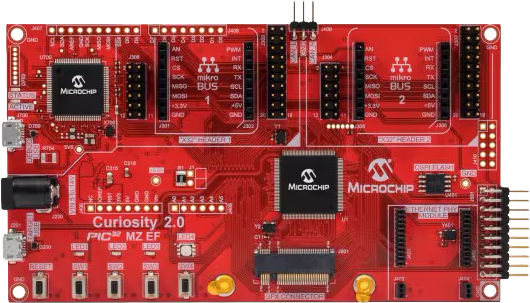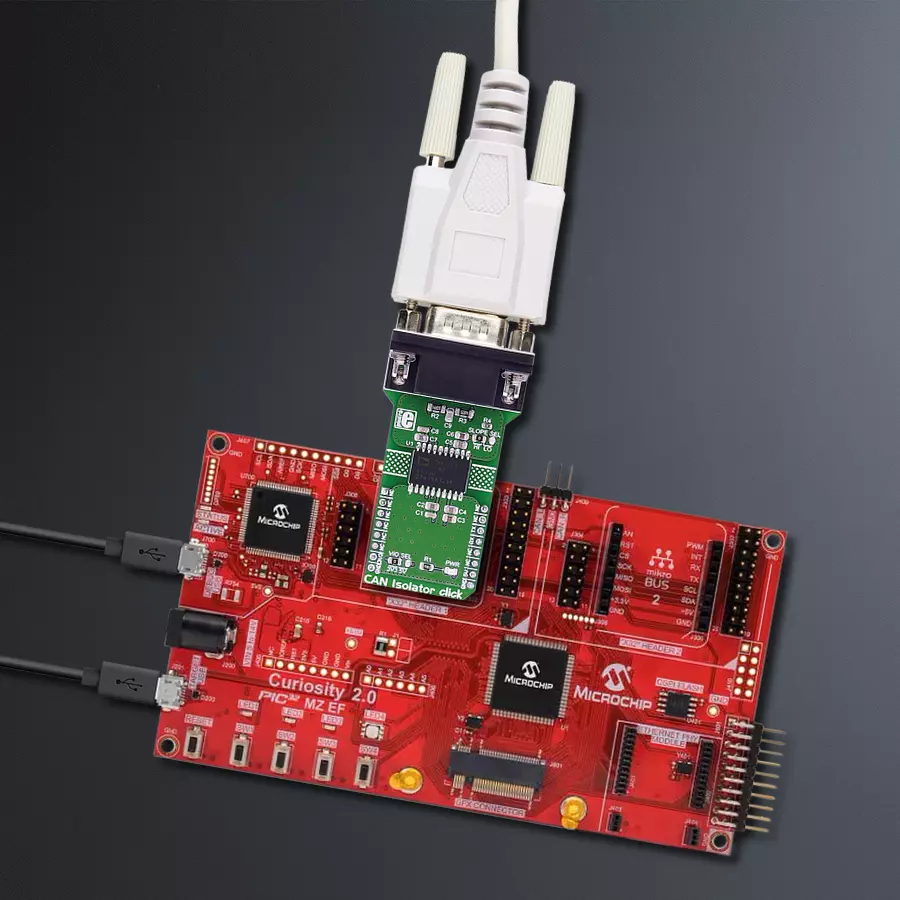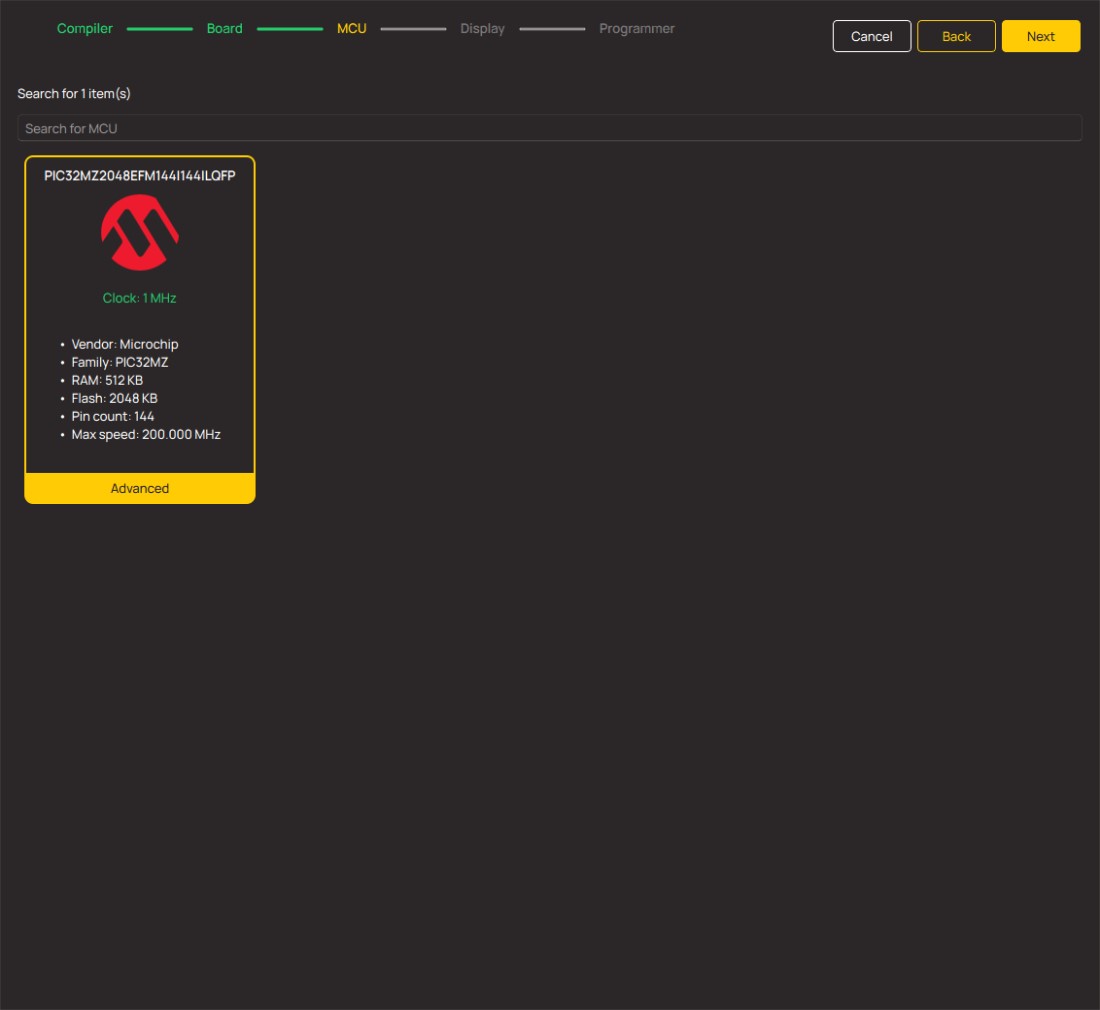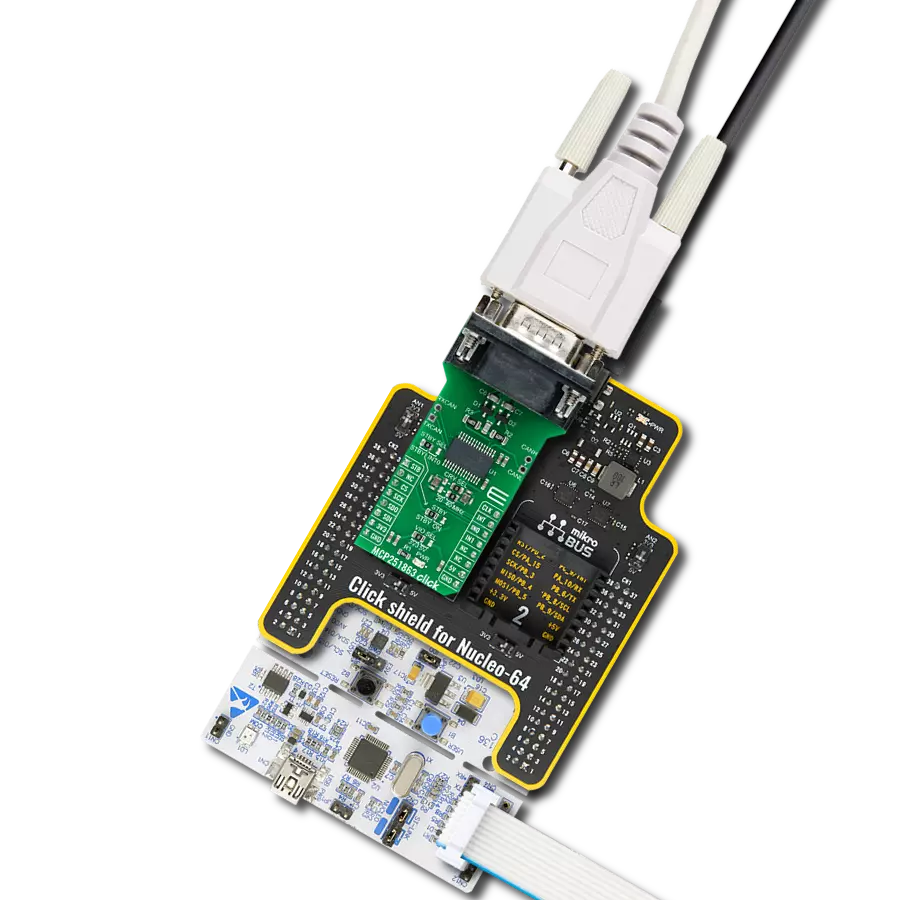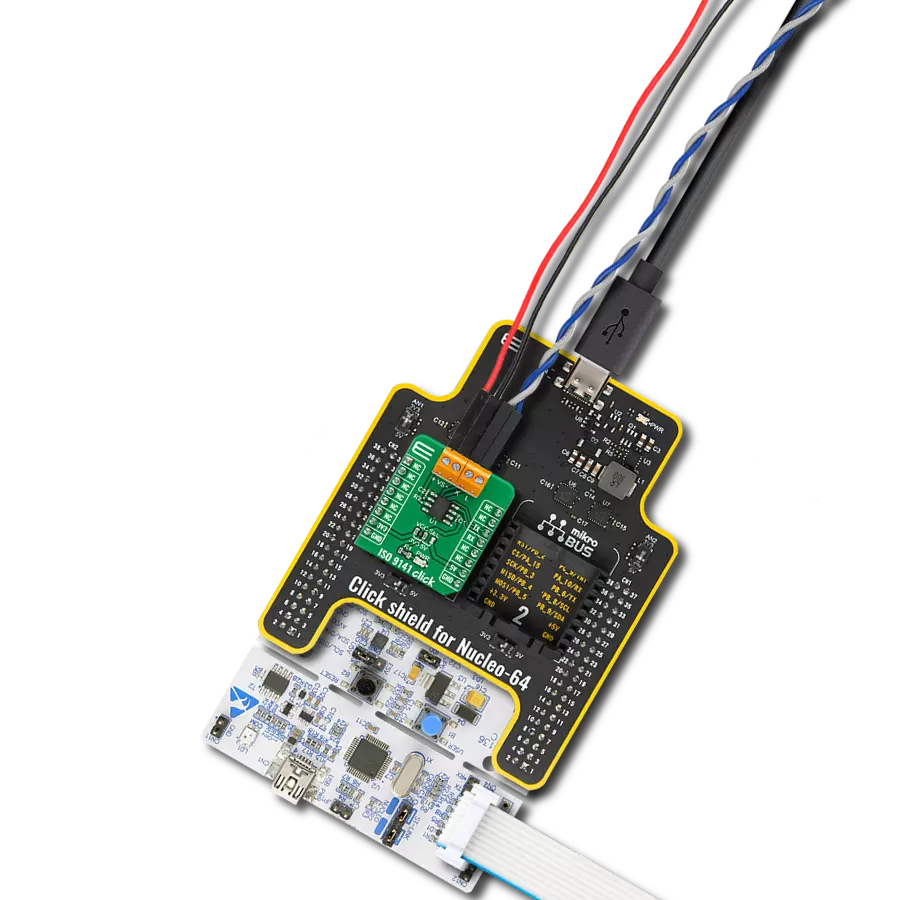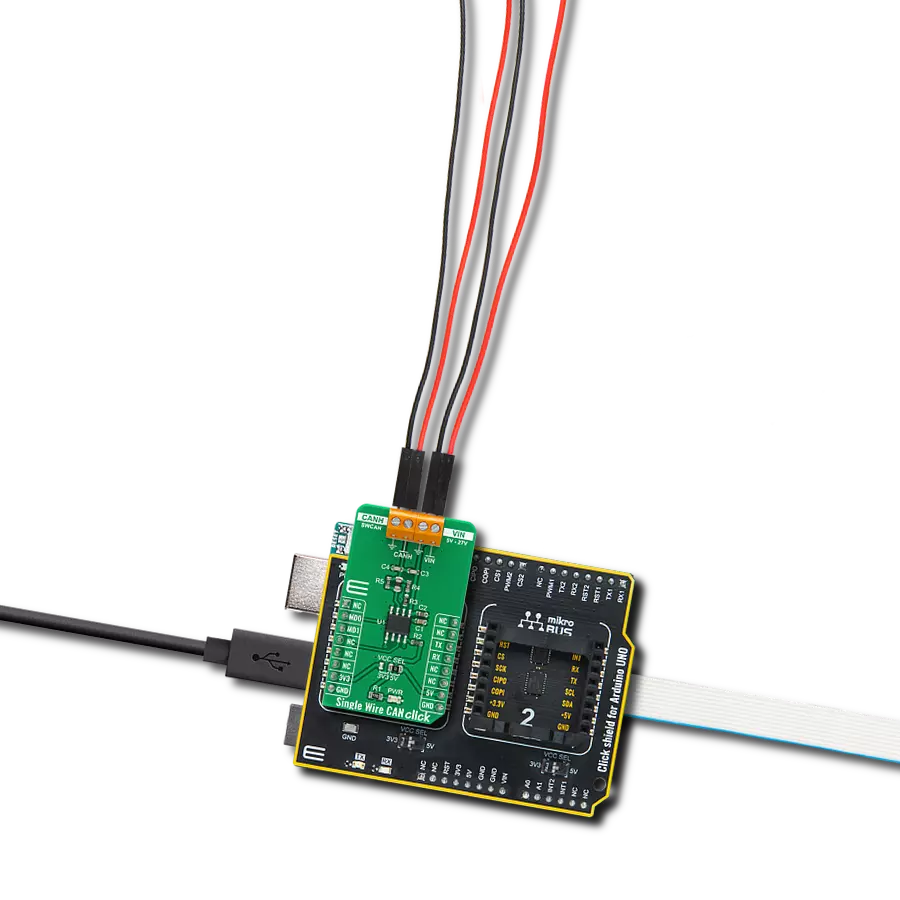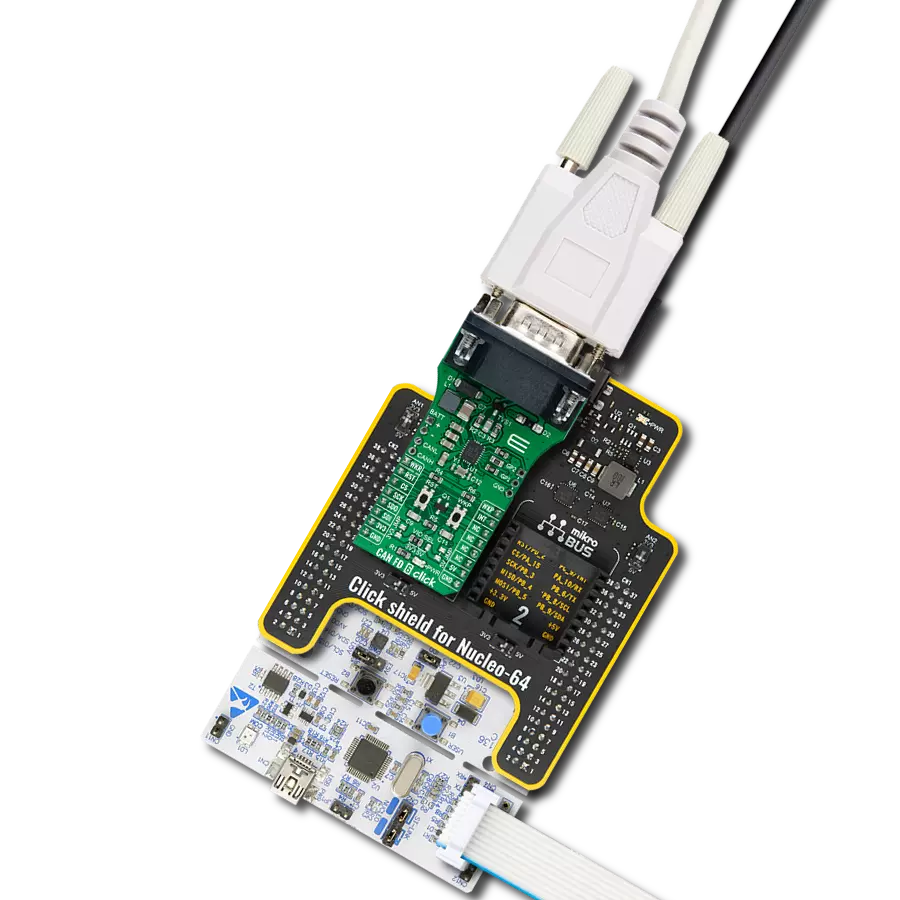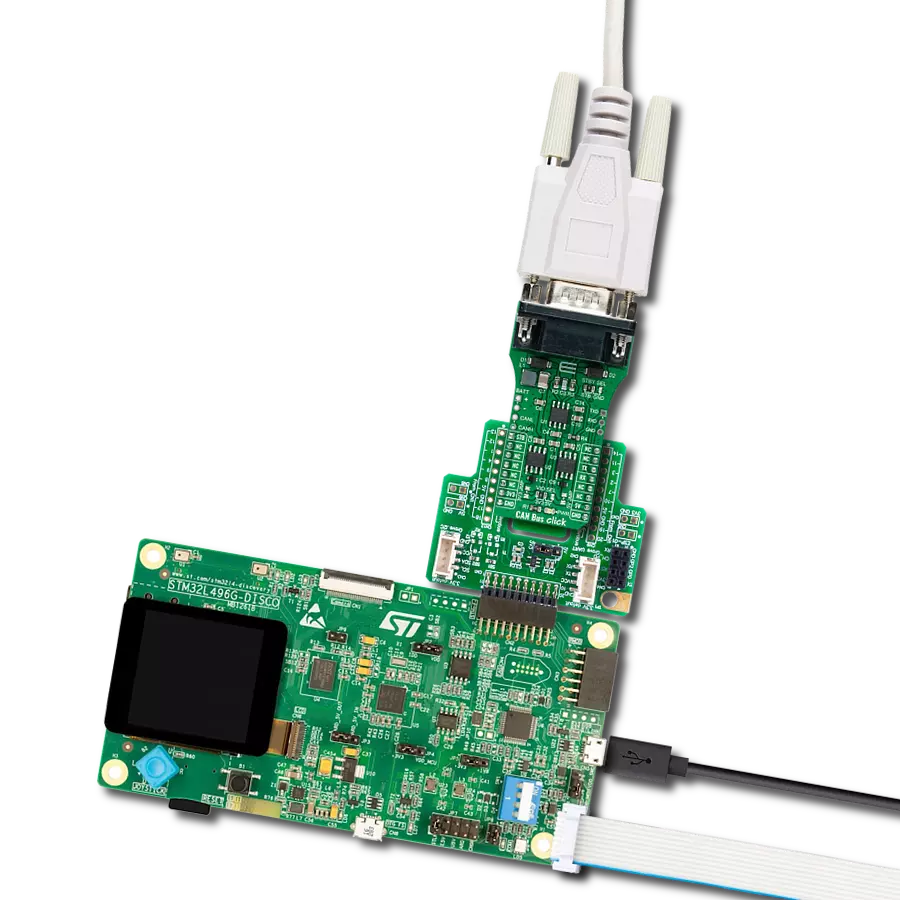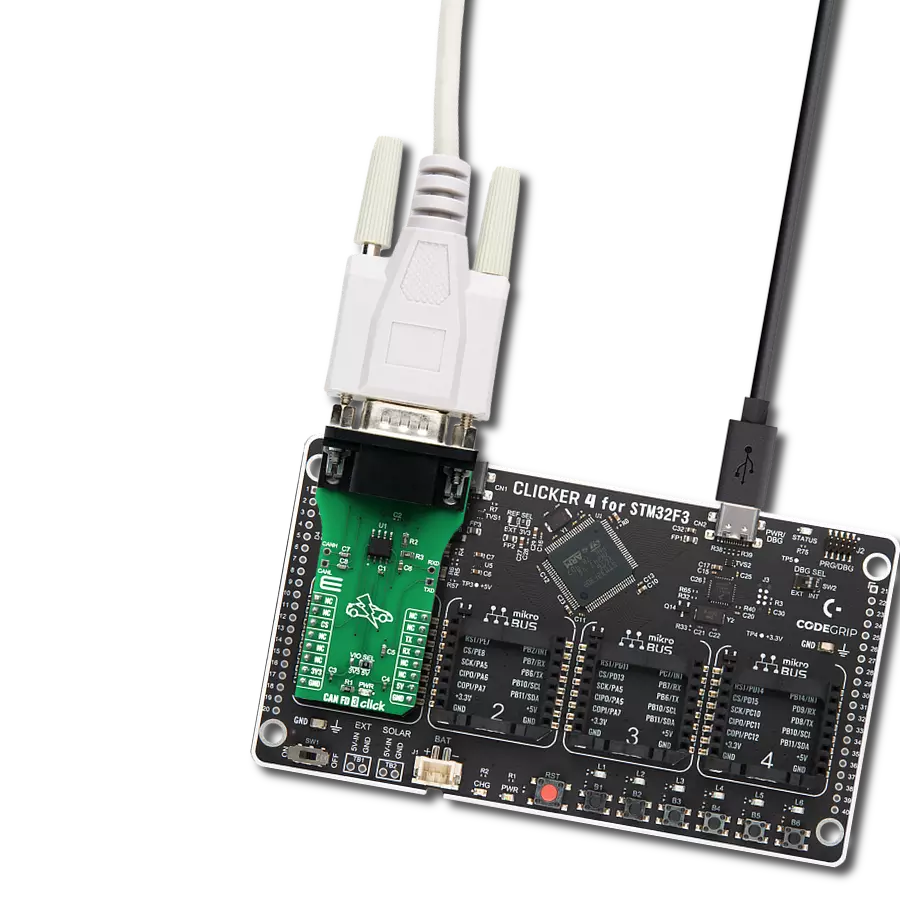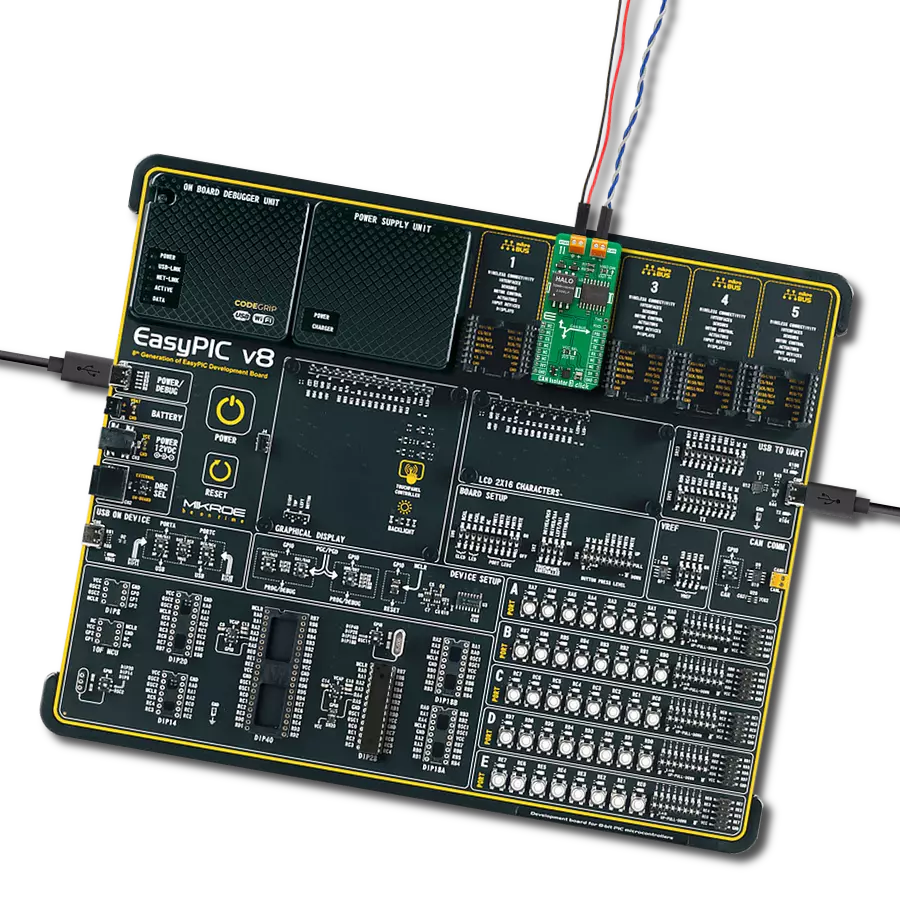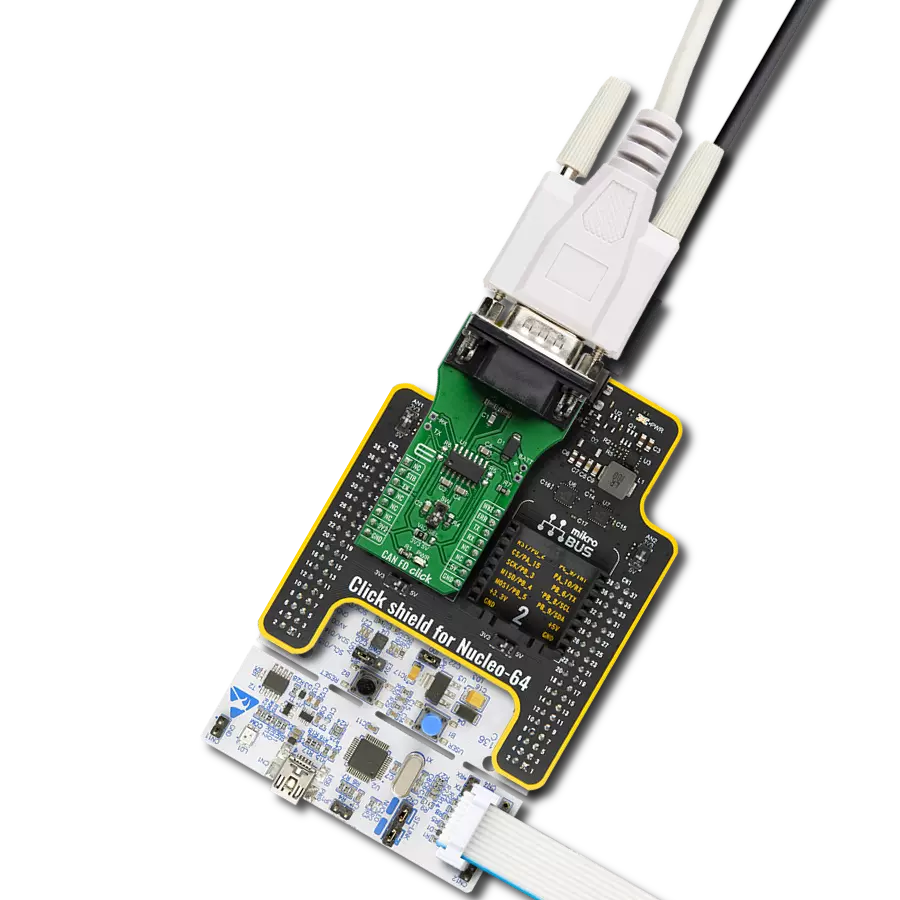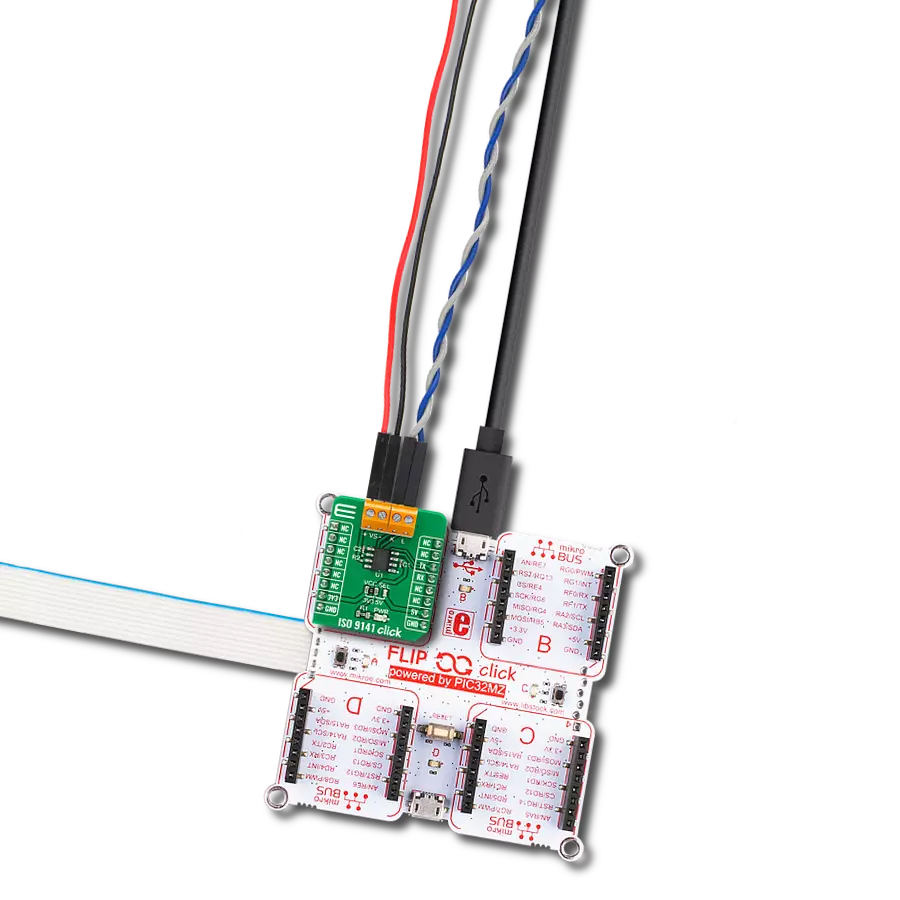This innovative solution optimizes signal integrity, enhances noise immunity, and efficiently manages power conversion, making it the ideal choice for critical applications
A
A
Hardware Overview
How does it work?
CAN Isolator Click is based on the ADM3053, a power isolated CAN transceiver with an integrated isolated DC-to-DC converter from Analog Devices. The click is designed to run on either 3.3V or 5V power supply. CAN Isolator Click communicates
with the target microcontroller over the UART interface. The ADM3053 is an isolated controller area network (CAN) physical layer transceiver with an integrated isolated DC-to-DC converter. The ADM3053 creates a fully isolated
interface between the CAN protocol controller and the physical layer bus. It is capable of running at data rates of up to 1Mbps.
Features overview
Development board
The Curiosity PIC32MZ EF 2.0 Development Board (DM320209) is a fully integrated development platform built around the high-performance PIC32MZ2048EFM144 microcontroller, featuring a 200MHz CPU, 2MB of Flash, and 512KB of SRAM. It comes equipped with an onboard PKoB4 debugger that provides real-time programming and debugging capabilities, along with a Virtual COM port (VCOM) and Data Gateway Interface (DGI), eliminating the need for any external programming hardware. The board is designed for flexibility and expandability, supporting a wide range of
application development needs through its multiple interfaces and expansion options. It includes two mikroBUS™ sockets for integration with MIKROE Click board™ add-ons, two X32 audio interfaces for Bluetooth® and audio functionality, and dedicated interfaces for Ethernet, graphics, and CAN communication. The board also supports Wi-Fi™ connectivity and audio I/O via compatible Microchip daughter boards, and features an Xplained Pro extension interface for additional peripheral expansion. User interaction is enabled through configurable buttons and LEDs, while 8MB of
onboard QSPI memory provides ample space for data storage in demanding applications. Additionally, the Arduino Uno R3 compatible interface allows easy connection with a wide range of Arduino shields. With its rich set of peripherals and robust processing capabilities, the Curiosity PIC32MZ EF 2.0 Development Board is ideally suited for developing complex applications such as Bluetooth® audio systems, IoT devices, robotics platforms, CAN-based networks, and advanced graphical user interfaces.
Microcontroller Overview
MCU Card / MCU
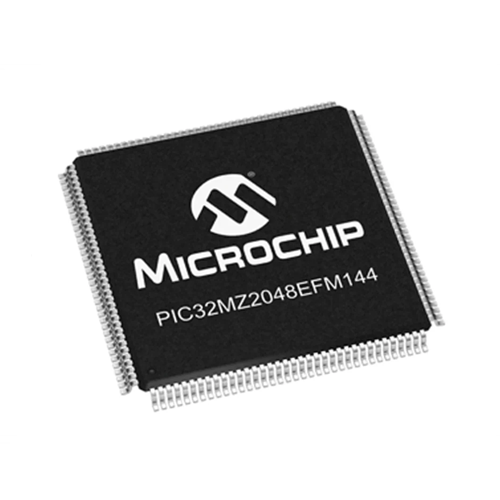
Architecture
PIC32
MCU Memory (KB)
2048
Silicon Vendor
Microchip
Pin count
144
RAM (Bytes)
524288
You complete me!
Accessories
DB9 Cable Female-to-Female (2m) cable is essential for establishing dependable serial data connections between devices. With its DB9 female connectors on both ends, this cable enables a seamless link between various equipment, such as computers, routers, switches, and other serial devices. Measuring 2 meters in length, it offers flexibility in arranging your setup without compromising data transmission quality. Crafted with precision, this cable ensures consistent and reliable data exchange, making it suitable for industrial applications, office environments, and home setups. Whether configuring networking equipment, accessing console ports, or utilizing serial peripherals, this cable's durable construction and robust connectors guarantee a stable connection. Simplify your data communication needs with the 2m DB9 female-to-female cable, an efficient solution designed to meet your serial connectivity requirements easily and efficiently.
Used MCU Pins
mikroBUS™ mapper
Take a closer look
Click board™ Schematic

Step by step
Project assembly
Track your results in real time
Application Output
1. Application Output - In Debug mode, the 'Application Output' window enables real-time data monitoring, offering direct insight into execution results. Ensure proper data display by configuring the environment correctly using the provided tutorial.

2. UART Terminal - Use the UART Terminal to monitor data transmission via a USB to UART converter, allowing direct communication between the Click board™ and your development system. Configure the baud rate and other serial settings according to your project's requirements to ensure proper functionality. For step-by-step setup instructions, refer to the provided tutorial.

3. Plot Output - The Plot feature offers a powerful way to visualize real-time sensor data, enabling trend analysis, debugging, and comparison of multiple data points. To set it up correctly, follow the provided tutorial, which includes a step-by-step example of using the Plot feature to display Click board™ readings. To use the Plot feature in your code, use the function: plot(*insert_graph_name*, variable_name);. This is a general format, and it is up to the user to replace 'insert_graph_name' with the actual graph name and 'variable_name' with the parameter to be displayed.

Software Support
Library Description
This library contains API for CAN Isolator Click driver.
Key functions:
canisolator_generic_multi_write- Generic multi write functioncanisolator_generic_multi_read- Generic multi read functioncanisolator_generic_single_read- Generic single read functioncanisolator_generic_single_write- Generic single write function
Open Source
Code example
The complete application code and a ready-to-use project are available through the NECTO Studio Package Manager for direct installation in the NECTO Studio. The application code can also be found on the MIKROE GitHub account.
/*!
* \file
* \brief CanIsolator Click example
*
* # Description
* This is a example which demonstrates the use of Can Isolator Click board.
*
* The demo application is composed of two sections :
*
* ## Application Init
* Configuring Clicks and log objects.
*
* ## Application Task
* Checks if new data byte has received in RX buffer ( ready for reading )
* and if ready than reads one byte from RX buffer.
* In the second case, the application task writes message data via UART.
* Results are being sent to the Usart Terminal where you can track their changes.
*
* \author MikroE Team
*
*/
// ------------------------------------------------------------------- INCLUDES
#include "board.h"
#include "log.h"
#include "canisolator.h"
// ------------------------------------------------------------------ VARIABLES
//#define DEMO_APP_RECEIVER
#define DEMO_APP_TRANSMITER
static canisolator_t canisolator;
static log_t logger;
static char demo_message[ 9 ] = { 'M', 'i', 'k', 'r', 'o', 'E', 13, 10, 0 };
// ------------------------------------------------------- ADDITIONAL FUNCTIONS
// ------------------------------------------------------ APPLICATION FUNCTIONS
void application_init ( void )
{
log_cfg_t log_cfg;
canisolator_cfg_t cfg;
/**
* Logger initialization.
* Default baud rate: 115200
* Default log level: LOG_LEVEL_DEBUG
* @note If USB_UART_RX and USB_UART_TX
* are defined as HAL_PIN_NC, you will
* need to define them manually for log to work.
* See @b LOG_MAP_USB_UART macro definition for detailed explanation.
*/
LOG_MAP_USB_UART( log_cfg );
log_init( &logger, &log_cfg );
log_info( &logger, "---- Application Init ----" );
// Click initialization.
canisolator_cfg_setup( &cfg );
CANISOLATOR_MAP_MIKROBUS( cfg, MIKROBUS_1 );
canisolator_init( &canisolator, &cfg );
log_printf( &logger, "---------------------\r\n" );
log_printf( &logger, " CAN Isolator Click\r\n" );
log_printf( &logger, "---------------------\r\n" );
Delay_ms ( 100 );
}
void application_task ( void )
{
char tmp;
#ifdef DEMO_APP_RECEIVER
// RECEIVER - UART polling
tmp = canisolator_generic_single_read( &canisolator );
log_printf( &logger, " %c ", tmp );
#endif
#ifdef DEMO_APP_TRANSMITER
// TRANSMITER - TX each 2 sec
uint8_t cnt;
for ( cnt = 0; cnt < 9; cnt ++ )
{
canisolator_generic_single_write( &canisolator, demo_message[ cnt ] );
Delay_ms ( 100 );
}
Delay_ms ( 1000 );
Delay_ms ( 1000 );
#endif
}
int main ( void )
{
/* Do not remove this line or clock might not be set correctly. */
#ifdef PREINIT_SUPPORTED
preinit();
#endif
application_init( );
for ( ; ; )
{
application_task( );
}
return 0;
}
// ------------------------------------------------------------------------ END
Additional Support
Resources
Category:CAN
